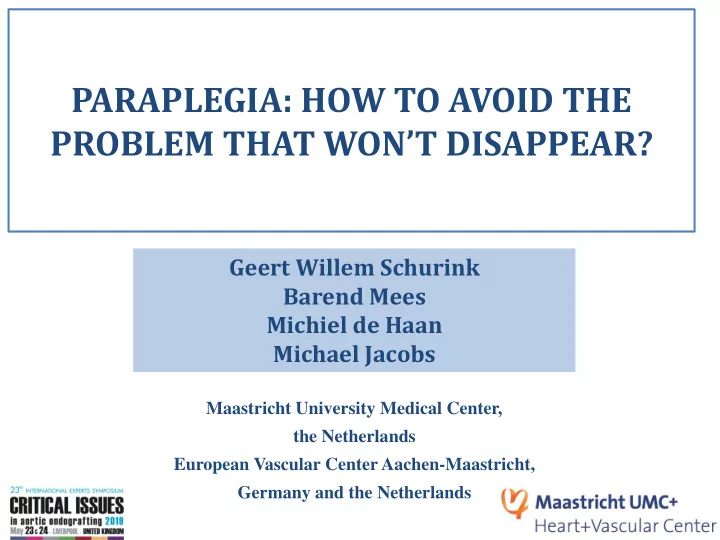

PARAPLEGIA: HOW TO AVOID THE PROBLEM THAT WON’T DISAPPEAR ? Geert Willem Schurink Barend Mees Michiel de Haan Michael Jacobs Maastricht University Medical Center, the Netherlands European Vascular Center Aachen-Maastricht, Germany and the Netherlands
PARAPLEGIA: HOW TO AVOID THE PROBLEM THAT WON’T DISAPPEAR ? Geert Willem Schurink Barend Mees Michiel de Haan Michael Jacobs Maastricht University Medical Center, the Netherlands European Vascular Center Aachen-Maastricht, Germany and the Netherlands
Disclosures • Consultant for COOK Medical
Strategies to prevent SCI Open repair Endovasc. repair – CSF drainage – CSF drainage – Preserve LSA and HA perfusion – Preserve LSA and HA perfusion – Spinal cord function monitoring – Spinal cord function monitoring – BP management – BP management – Staged repair – Staged repair
Only endovascular repair of TAAA: • 11 publications Bisdas T et al. (2015) • 873 patients Dias NV et al. (2015) Guillou M et al. (2012) Harrison C et al. (2012) Jayia P et al. (2015) • Permanent SCI: 3,6% Kasprzak PM et al. (2014) Kato M et al.(2015) Kitagawa A et al. (2013) Maurel B et al. (2015) Rossi SH et al. (2015) Sobel JD et al. (2015)
Permanent paraplegia in endoTAAA 3,6 All studies 12,8 Neuromonitoring 4,9 Permissive temporary endoleak >2 preventive measures ≤2 preventive measures 5 Selective LSA revascularization Profylactic spinal fluid drain Selective spinal fluid drain 3,1 Staged procedures Avoidance of hypotension Staged procedures 3,6 Avoidance of hypotension Selective LSA revascularization Permissive temporary endoleak 2,2 Selective spinal fluid drain Neuromonitoring 8 Profylactic spinal fluid drain All studies 2,1 ≤2 preventive measures 4 >2 preventive measures 0 2 4 6 8 10 12 14
Permanent paraplegia in endoTAAA 3,6 All studies 12,8 Neuromonitoring 4,9 Permissive temporary endoleak >2 preventive measures ≤2 preventive measures 5 Selective LSA revascularization Profylactic spinal fluid drain Selective spinal fluid drain 3,1 Staged procedures Avoidance of hypotension Staged procedures 3,6 Avoidance of hypotension Selective LSA revascularization Permissive temporary endoleak 2,2 Selective spinal fluid drain Neuromonitoring 8 Profylactic spinal fluid drain All studies 2,1 ≤2 preventive measures 4 >2 preventive measures 0 2 4 6 8 10 12 14
Permanent paraplegia in endoTAAA 3,6 All studies 12,8 Neuromonitoring 4,9 Permissive temporary endoleak >2 preventive measures ≤2 preventive measures 5 Selective LSA revascularization Profylactic spinal fluid drain Selective spinal fluid drain 3,1 Staged procedures Avoidance of hypotension Staged procedures 3,6 Avoidance of hypotension Selective LSA revascularization Permissive temporary endoleak 2,2 Selective spinal fluid drain Neuromonitoring 8 Profylactic spinal fluid drain All studies 2,1 ≤2 preventive measures 4 >2 preventive measures 0 2 4 6 8 10 12 14
Permanent paraplegia in endoTAAA 3,6 All studies 12,8 Neuromonitoring 4,9 Permissive temporary endoleak >2 preventive measures ≤2 preventive measures 5 Selective LSA revascularization Profylactic spinal fluid drain Selective spinal fluid drain 3,1 Staged procedures Avoidance of hypotension Staged procedures 3,6 Avoidance of hypotension Selective LSA revascularization Permissive temporary endoleak 2,2 Selective spinal fluid drain Neuromonitoring 8 Profylactic spinal fluid drain All studies 2,1 ≤2 preventive measures 4 >2 preventive measures 0 2 4 6 8 10 12 14
Distribution of types of TAAA in published series 0 100 4,5 8,2 16,7 90 25 16,9 26,7 31,8 80 21,3 45,6 10,4 0 70 Type IV 10,4 16,7 28,1 25 60 14,2 Type III 8,9 100 37,7 50 14,2 Type II 12,2 40 40 Type I 60,4 30 50,6 50 20 37,5 33,3 30,7 10 16,7 0 0 0 1 2 3 4 5 6 7 8
Strategies to prevent SCI Introduction of: • TEVAR staging • LSA & HA preservation • CSF drainage in type 1-3 • Early pelvic reperfusion • Aggressive blood, plasma and platelet Tx • MAP 85-90 mmHg
Staging TAAA Both open and endo repair: • Previous aortic repair (Historical staging) • Multiple aortic repair (open or TEVAR) • Segmental Artery Coil Embolization (MIS2ACE) Only Endo repair • “Open branch” staging
Results EndoTAAA (n=112) • Historical staging: 28% – 35% abdominal aorta – 58% thoracic aorta 7% both thoracic &abd aorta – • TEVAR staging: 9 % – TAAA type 2 with carotid-subclavian bypass • Open branch staging: 20% – Using MEPs during last branch occlusion – Reason for open branch: • 86% MEP. (> 50%) • 14% Endoleak during branch occlusion
MEPS @ Crawford extent 2 endo TAAA repair with multivessel BEVAR Spinal Cord Peripheral tib.ant.Re Ischemia ischemia Right tib.ant.Li 1500 110 abd.poll.br.Re Leg 1400 abd.poll.br.Li 100 rect.fem.R 1300 rect.fem.L 90 T1% 1200 1100 80 1000 70 MEP amplitude [mV] 900 60 800 700 50 600 40 500 30 400 300 20 200 10 100 0 0 time Increase vs decrease upperleg MEPS
Results EndoTAAA (n=112) 16 SCI • Spinal cord ischemia: 6% 14 no SCI 12 10 – 4/7 improved (all walking) 8 6 – 1/7 cured 4 2 0 – 2/7 no improvement
Cleveland Clinic Experience Cleveland Clinic Experience 25% 20% 15% 10% 5% 0% type I type II type III type IV (ER=82;OR=51) (ER=16;OR=59) (ER=22;OR=62) (ER=69;OR=64) Endovascular Repair (n=189) Open Repair (n=236) Greenberg, Circulation. 2008;118:808-817
SCI in endoTAAA (n=112) • Preop. Crawford classification Spinal Cord Ischemia type N= complete partial I 23 0 0 II 18 1 2 III 34 1 1 IV 27 1 1
‘Open Branch ’ staging in endoTAAA TRUE 35 UNTRUE 30 28% 14% 25 13% 20 29% 15 10 5 0 type I type II type III type IV
Conclusions Spinal cord ischemia is still a serious problem in • endovasc repair of TAAA. In endoTAAA SCI seem to decrease with current • protocols. Current protocol is set of adjunctive measures • not clear which is essential/unimportant – Staging is an effective way to reduce SCI • Selective staging with MEP during branch test • occlusion is associated with low spinal cord ischemia rate in endoTAAA – more frequent staging in Crawford type 2 and 3 – no need for staging in 80% –
Recommend
More recommend